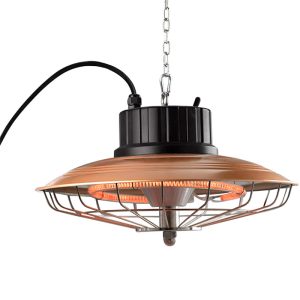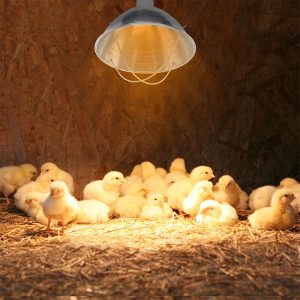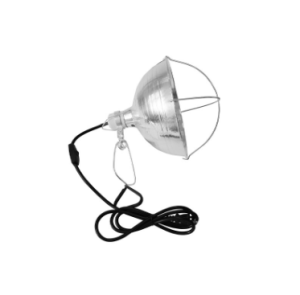5 Crucial Temperature Guidelines for Using a Heat Lamp with Baby Chickens
Article Summary:
It is very essential to know the right brooding temperature of your chicks. This blog is going to give you the exact temperature specifications, detailing the timeline and process of efficient use of a heat lamp.
Reminder to Continue Reading:
Keep reading to learn the precise week-by-week temperature schedule, and how getting the temperature wrong can have a severe impact on the growth, health and well-being of your chicks.
1. Introduction:
The first few weeks of a baby chick’s life are the most critical. Unlike adult birds, chicks are unable to regulate their own body temperature and so consistent and safe warmth is critical for their survival and healthy development.
This warmth is usually supplied by a heat source. While a traditional heat lamp is often a common option, a safer radiant brooder plate is often a better overall solution because of the elimination of fire risk. Regardless of what kind of equipment you use, getting the correct setting for your heat source is the single most important task.
2. The Temperature Challenge: When and Why Heat Matters
The challenge to every new chick parent is precision: How do you achieve the high level of warmth required without overheating or chilling your birds? This is why we need to set the 5 essential temperature rules for using a heat lamp with baby chicks straight.
Failure to keep the appropriate weekly temperature can result in:
- Pasting Up: Caused by dehydration (from excessive heat).
- Huddling/Piling: Caused by Chilling, Suffocation/Illness
The easy solution is to be on a strict temperature schedule and allow your chicks to tell you when to adjust.
3.The 5-Week Temperature Guide
The basic rule is quite simple: Chicks begin at 95∘F (35∘C) and it cools 5∘F with each passing week.This drop helps them to adjust to low temperatures as they grow their feathers.
The first seven days are the most delicate. The temperature under the lamp must be kept at 95∘F. Set your lamp or plate and use a thermometer placed at chick level to confirm the heat.
The Weekly Drop Schedule (Weeks 2-5)
Change the heat source once a week to follow this schedule:
| Week | Required Temperature |
| Week 2 | 90∘F (32∘C) |
| Week 3 | 85∘F (29∘C) |
| Week 4 | 80∘F (27∘C) |
| Week 5 | 75∘F (24∘C) |
Monitoring Behavior (The True Thermometer)
Your chicks are your best guides as to the proper temperature. You need to set your lamp height according to their behaviour, not just the thermometer:
- Too Cold: Chicks huddle together, pile up and peep loudly. Lower the lamp or turn the heat up.
- Too Hot: Chicks are scattering, panting or actively avoiding the center of the lamp. Raise the Lamp or lower the heat setting.
- Just Right: Chick are spread out evenly in the brooder, eating, drinking and sleeping quietly.
- Safety Tip: Always use a safer brooder plate and/or have your heat lamp secured with a chain and wire guard to avoid fire hazards.
Achieving Temperature with Lamp Placement
If using a heat lamp, the temperature required is attained by varying the height of the lamp above the litter.A higher lamp equals a lower temperature and a lower lamp equals a higher temperature. Place the lamp high enough that the chicks can select a place that is comfortable for them.
- Product Recommendation: It is important to use a brooder thermometer for accuracy. Buy a good Brooder Thermometer (Amazon link), to make sure your settings are accurate.
When to Stop Using Heat (Around 6 Weeks)
As of Week 6, chicks are typically completely covered in feathers and should be fine in an ambient temperature of 70 degrees F (21∘C) or higher. At this stage, you can safely remove them from the supplemental source of heat (unless there are severe drafts or sudden drops in temperature).
4. Conclusion:
Controlling the temperature drop from week to week is essential to producing hardy, healthy chicks. By following these 5 Crucial Temperature Guidelines for Using a Heat Lamp with Baby Chickens and most importantly listening to the cues your chicks give you, you can make sure your chicks are comfortable and growing as much as possible. Don’t take the power of a thermometer and the safety of a secure set up lightly.
Need a good thermometer to monitor the weekly temperature of your chicks? [add link]
5. FAQ
Q1. What is a too cold temperature for baby chicks at night?
Any temperature below 95∘F (35∘C) in the first week is too cold and may cause severe stress, chilling and possible death.Maintain required weekly temperature even overnight.
Q2. Do chicks need heat lamps at 6 weeks?
Generally, no. 6-week-old chicks are generally fully feathered and can be removed from supplemental heat if the ambient temperature is consistently above 70∘F (21∘C).
Q3. How far away should the heat lamp be from the chicks?
There is no fixed distance. The distance of the lamp will have to be adjusted until the thermometer reads the correct temperature (95∘F in week one) at chick level. This often varies between 18 and 30 inches (45[∘75cm).
Q4. Is a ceramic heat emitter better than a red heat lamp bulb?
Yes. Ceramic heat emitters (CHEs) are good sources of intense heat which do not provide light, allowing chicks to experience a natural day/night cycle which promotes better rest and development.
Q5. What are the major signs of chicks being too hot?
If chicks get too hot, they will pant and spread their wings and move aggressively to the far edges of the brooder, away from the heat source.







